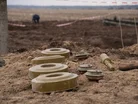How AWS is Using AI to Help De-mine Ukraine

The Ukraine war, the biggest conflict on European soil since WW2, has wrought havoc on the country.
In addition to the bloodshed, destroyed cities, and wrecked lives, one scar on the landscape remains under the surface, ready to release even more destruction.
Despite a 1997 international convention on the prohibition of using anti-personnel mines, this war has seen Ukraine become the largest minefield in the world - with as many as two million mines scattered across land. Russia is not a signatory to this agreement.
Yet hope is on the horizon. With the boom in AI ushering in all sorts of use cases for enterprises, Amazon Web Service (AWS) has turned its AI and machine learning (ML) capabilities towards helping humans caught up in the conflict.
AWS has invested a US$4m package of support to enable The HALO Trust – the world's largest humanitarian landmine clearance organisation - to trial AI to assist in the process of detecting debris of war.
How AI assists in mine detection
HALO has a history of mine clearance, beginning operations in Cuito Cuanavale in 2005 and by the end of 2022, it had cleared 29,000 AP mines and 11,000 AV mines.
As technology improved, so did their methods of detecting. HALO uses satellite and drones to broadly survey huge swaths of land so that its more than 11,000 global staff can effectively pinpoint what areas need to be meticulously cleared by hand or by machine.
Yet, this can still prove a risky task for those on the ground excavating, as one small mistake can be the difference between life and death. This is where AI comes into play.
"Technology, and in this case, AI specifically, has enormous potential to help solve major global challenges, and we're looking forward to working with HALO by enabling them to better harness the power of the satellite and drone imagery they are collecting to accelerate the clearing process," said Dave Levy, VP for Worldwide Public Sector at AWS on the announcement.
AI, like in many other scenarios, is good at interpreting data and then spotting patterns to help decode what this means. As with all AI models, it needs huge datasets so it can learn reliably enough that it can make informed decisions.
HALO has currently flown 542 drone flights over Ukraine's minefields, providing up to 11 terabytes of high-resolution imagery. It is this data that can be analysed through AI to accurately help expedite the detection of landmines.
In addition to drone imagery analysis, HALO is leveraging AWS's cloud capabilities in other innovative ways. Using AWS SageMaker, a ML service, HALO is running AI and ML algorithms on satellite imagery to identify damaged buildings.
AWS is also powering HALO's open-source mapping project in Ukraine. This initiative integrates open-source data from various sources via API into a central data repository hosted on AWS. This comprehensive mapping helps HALO better understand and communicate the nature of the explosive threat across different regions.
"AWS support will also be transformative in how our organisation safely stores, processes, analyses, and disseminates the vast quantity of real-time data we collect through our global operations in the cloud – including in active warzones like Ukraine," said HALO's CEO, James Cowan.
AWS support includes credits that enable HALO to leverage its AWS cloud storage for photos, spatial, and non-spatial data, and train staff to optimise its use. Equally, because HALO often needs this information in places with little-to-no connectivity, AWS enables them to work offline and upload content to the cloud when bandwidth permits for AI and ML processes to occur.
Another significant benefit of using AWS is the hosting of HALO's suite of business intelligence tools. These tools provide critical insights into HALO's operations, allowing for more efficient resource allocation and strategic planning in their demining efforts.
A continual process
Training AI to identify explosive remnants of war with drone imagery is not an overnight process, however.
Like refining other models, it requires manually labelling thousands of images (e.g., trenches, different varieties of anti-tank mines) so that the algorithms can learn how to survey minefields more efficiently than humans are currently doing manually.
It also requires ongoing vetting and validation of the model by trained personnel to eliminate false positives and negatives and improve the accuracy of the model.
Yet, HALO expects this pilot project will begin trialling drone imagery analysis using AI in the coming months, and should it prove successful, the gains will be measured not in monetary returns, but in lives saved.
******
Make sure you check out the latest edition of AI Magazine and also sign up to our global conference series - Tech & AI LIVE 2024
******
AI Magazine is a BizClik brand

